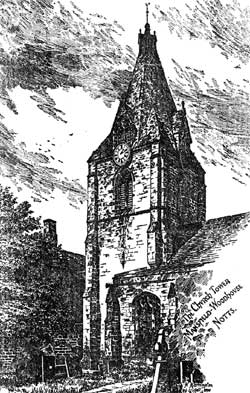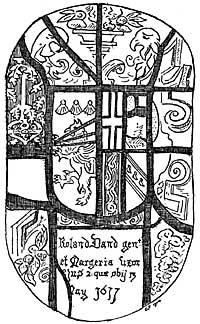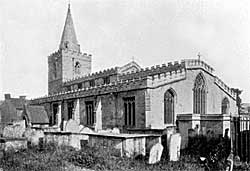Mansfield Woodhouse and Mansfield

Mansfield Woodhouse church.
At 12.45 p.m., Hardwick Hall was left behind, and our way made towards the inn where a well-served luncheon was very welcome, and was fully appreciated. After luncheon, most of our members strolled, by way of the park, to the top of the hill, before taking their seats in the brakes. The Chesterfield Road was then struck, via Rowthorne, and our journey was continued by way of the beautiful vale of Pleasley, which looked its best on this June afternoon. Mansfield Woodhouse was reached about 3.30 p.m. Here the vicar, the Rev. C. Webb, Mrs. Webb, Mr. and Mrs. F. J. Turner, Mrs. and Miss Need, met the visitors.
The members of the Society were indebted to the Rev. C. Webb for kindly affording them information about his church, in which he has been instrumental in introducing several improvements during his incumbency. He mentioned that George Fox was stoned here in the 17th century; also that the parish was notorious for the number of bridges it contained, in consequence of the stream that runs through the village, near to which traces of a Roman villa have been found.
Mr. George Fellows has furnished the following additional information.
Mansfield Woodhouse, no doubt, derived its name from its proximity to Sherwood Forest. Leland refers to it as "a little poor street at the end of this wood," and, in the more remote times of Henry VI., a Sir Robert Plumbton held a piece of ground here by service of sounding a horn to drive away the wolves.
The church of St. Edmund underwent a considerable restoration at the hands of Mr. (afterwards Sir) Gilbert Scott in the year 1847, which resulted in a very appreciable change in the appearance of the structure, for he did away with the clerestory, and substituted the present high-pitched slate roof, and built the north aisle. The church, however, has passed through other vicissitudes, for Thoroton quotes from an old forest book, written 1520 or 1533, "Be it had in mynd that the Towne of Maunsfeld Woodhouse was burned the Saturdays nexte afore the Fest of Exaltation of the holy Crosse, the yere of our Lord M.CCC.IIII. And the Kirk Stepull, with the Belles of the same, for the Stepull was afore of Tymber worke: and part of the Kyrk was burned."
The present steeple was built after this demolition. This and the Early English south arcade, with its clustered and filleted columns, and the side chapel, are the oldest and most interesting portions of the present fabric.
This new steeple in stone was commenced in 1306, and consists of a tower in three stages, the two lower being of the Early English, and the top one, containing the belfry windows, of the Decorated period, and is supported by strong buttresses at each angle.
The broach spire is peculiar in having the upper range of lights, which are unpierced, close to the apex of the spire; it is now braced together in several places with iron clamps, having been badly cracked by a severe earthquake shock, which occurred during service on a Sunday morning in the summer of 1830.
In the chantry chapel referred to is a monument in stone to Sir John Digby and his wife, Lucia, daughter of Thomas Trigget, of South Kirby, Yorks, with a long inscription beneath. He came of an illustrious family, and was a staunch supporter of King Charles I. He died 1684. His grandson died without a male heir, and the estates were sold in 1736 to John Hall, Esq., whose descendants still own half the chapel; the right to the other half having eventually passed with the possession of the Digbys' old manor house, which adjoins the church, to the Duke of Portland.
There is a plain stone font, which Sir Stephen Glynne pronounced to be Norman. Its simplicity has been impaired by having texts painted round it in recent years. The stone pulpit is supported on a corbel representing Eve eating the apple.

Dand window.
In the vestry window is a nice piece of old stained glass, showing the arms of Roland Dand, impaling those of his second wife, Margery, daughter of Lawrance Woodnoth, of Shennington, co. Chester, with quarterings, which, however, are difficult to make out, but the fourth is gules, on a bend cotised or, three birds.
The Dand arms are vert, a griffin segreant or, in chief three scallops of the last, and were granted to Rowland Dand in 1575. A pedigree of the Dands is given in the Visitations of Notts. The Woodnoth arms are argent, a cross voided sable.
This shield of arms in the window is surrounded by coloured glass representing fruit, flowers, etc.; it has evidently been broken at some time. One piece of fancy glass is now doing duty for a quartering in the wife's arms. It is well that a record should be made of this piece of old glass, for whilst it is permitted to retain its present position, it is liable to be shattered at any moment should a gust of wind blow the window to. It might with advantage be transferred, and fixed in one of the windows in the side chapel, which need beautifying.1 Besides this glass there is also a mural tablet to this couple on the north wall of the chancel, with two shields of arms beneath. He died 1623, having survived his wife six years.
Outside the church is a tablet to William Tunstall, who was taken prisoner at the battle of Preston, 1715, but was subsequently pardoned by the King.
The registers commence in 1653. They are in poor condition, being on loose sheets: it is therefore gratifying to hear that a copy of them is about to be made.
The new colliery opened here has entirely changed the character of the place from the charming country village it was a few years ago.

St Peter's church, Mansfield, c.1912.
On arriving at Mansfield, the church of St. Peter was visited. Here Mr. J. P. Briscoe read a paper, in which he referred to the great number of restorations that had been effected here in rapid succession, and how a modern restoration had swept away "a cloud of galleries," which at one time spoilt the appearance of the church, and also the old high pews. He further pointed out that the figure, which is popularly said to represent Dame Cicely Flogan, a benefactress to Mansfield, had every appearance of being that of a man (circa 1350), that is, a century and a half earlier than Dame Flogan's day. It was probably an effigy of one of the Pierreponts.2
After Mr. Briscoe had concluded his paper, Canon Prior shewed our members many interesting details recently discovered; and Mr. W. Stevenson pointed out the north porch doorway, as a very beautiful and characteristic example of the Early English period. He also drew attention to the remains of the double lancet window, plainly discernible on the west wall of the north aisle. The roof line on the east face of the tower, he held to be evidence of the old church, recorded in Doomsday, the oldest church within a considerable radius. The recovered fragments of an incised slab recently erected in the south chapel, is viewed as a memorial of a former vicar, but whether that vicar was William de Berkhampton, who died in 1372, or James Heyton, who died in 1475, both of whom were buried in the chancel, is not clear.
The incised figure is that of a priest in vestments, and holding a chalice, and the opening words of the inscription I C I G V T (here lies), which alone are legible, shew that Norman French was the language used at the time.
From the broken character of this slab, and from an incised cross on the centre, Mr. W. H. St. John Hope, Secretary of the Society of Antiquaries, London, considers that it may possibly have been used as a Marian altar-slab, improvised from an old floor-slab and removed and broken up in the reign of Elizabeth; but it remains a question whether the cross is not an original decoration of the orphrey on the chasuble.
Tea at the Swan Hotel was provided at 4.30 p.m., after which our members dispersed, and proceeded homewards by train via Nottingham and Newark, after having spent a most enjoyable day.
(1) Since writing the above,
we are glad to learn that this is to be carried out.—Jt. Eds.
(2) There is a figure very much resembling this one at Holme Pierrepont Church.—Jt.
Eds.
